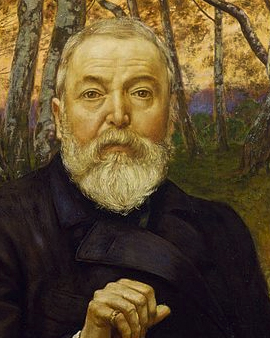Hans Thoma (1839 - 1924) was born in the Black Forest as the son of a trained miller. He began some apprenticeships, first as a lithographer and later as a clock shield painter, but broke them both off prematurely. He learned the basics of painting and finally joined the Karlsruhe Academy in 1859. He studied under the tutelage of Johann Wilhelm Schirmer and Ludwig Des Coudres. Des Coudres had the greatest influence on his career. After his graduation in 1866 Thoma moved through different cities, such as Basel, Düsseldorf and Paris. During his time in Paris he was particularly impressed by the paintings of Gustave Courbets.
During his wandering years, Thoma's works were only marked by mediocre success. It was only in Munich, then the art capital of Germany, that Thoma was able to establish his reputation as a painter nationwide with an exhibition of around 30 paintings in 1890. In Munich he also met his wife, the painter Cella Berteneder. In his painting "Auf einer Waldwiese" she stood model for her husband. The peak of his career finally came in 1899, when Thoma was able to move into an apartment next to the cemetery together with his family. For Thoma, this was final proof that his work was recognized as a painter. In the same year he was also appointed professor at the Karlsruhe School of Art. The death of his wife in 1901 hit Thoma hard, whereupon he suffered from depressions for years.
Thoma had many friends in painting circles, such as Wilhelm Steinhausen, with whom he lived next door for a while, or Otto Scholderer. At that time Thoma travelled to Paris with Scholderer. Although Thoma studied with various masters, his works showed few modern influences. Many of his paintings show landscapes and idyllic scenes, which are influenced by his early impressions from his home region. These include works such as "Der Rhein bei Säckingen", "Schwarzwaldlandschaft" or "Sommer". Thoma made many portraits of his close friends and family members. Equally convincing are the numerous portraits of his close friends. family members and his self-portraits. Among his weakest and worst rated pictures are the mythological-religious motifs such as "Eight dancing women in bird bodies" or "Temptation on the mountain". They are generally felt to be overdrawn and are stylistically reminiscent of the works of the Swiss painter Arnold Böcklin.
×





.jpg)
.jpg)
.jpg)
.jpg)
.jpg)
.jpg)
.jpg)
.jpg)
.jpg)
.jpg)
.jpg)
.jpg)
.jpg)
.jpg)
.jpg)
.jpg)
.jpg)
.jpg)
.jpg)
.jpg)
.jpg)
.jpg)
.jpg)
.jpg)
.jpg)
.jpg)
.jpg)
.jpg)
.jpg)
.jpg)
.jpg)
.jpg)
_Peinture_de_Hans_Thoma_(1839-1924)_Huile_sur_toile_-_(MeisterDrucke-1323183).jpg)
_Peinture_de_Hans_Thoma_(1839-1924)_Huile_sur_toile_-_(MeisterDrucke-1323183).jpg)
.jpg)
.jpg)
.jpg)
.jpg)
.jpg)
.jpg)
.jpg)
.jpg)
.jpg)
.jpg)
.jpg)
.jpg)
.jpg)
.jpg)
.jpg)
.jpg)
.jpg)
.jpg)
.jpg)
.jpg)
 1896 (engraving - (MeisterDrucke-294875).jpg)
 1896 (engraving - (MeisterDrucke-294875).jpg)
.jpg)
.jpg)
_-_(MeisterDrucke-377178).jpg)
_-_(MeisterDrucke-377178).jpg)
.jpg)
.jpg)
.jpg)
.jpg)
.jpg)
.jpg)
.jpg)
.jpg)
_1895_-_(MeisterDrucke-376915).jpg)
_1895_-_(MeisterDrucke-376915).jpg)
.jpg)
.jpg)
.jpg)
.jpg)
.jpg)
.jpg)
.jpg)
.jpg)
.jpg)
.jpg)
.jpg)
.jpg)
.jpg)
.jpg)
.jpg)
.jpg)
.jpg)
.jpg)
.jpg)
.jpg)
.jpg)
.jpg)
.jpg)
.jpg)
_-_(MeisterDrucke-570119).jpg)
_-_(MeisterDrucke-570119).jpg)
.jpg)
.jpg)
.jpg)
.jpg)
.jpg)
.jpg)
.jpg)
.jpg)
_-_(MeisterDrucke-1174536).jpg)
_-_(MeisterDrucke-1174536).jpg)
.jpg)
.jpg)
.jpg)
.jpg)
.jpg)
.jpg)
.jpg)
.jpg)
.jpg)
.jpg)
.jpg)
.jpg)
.jpg)
.jpg)
.jpg)
.jpg)
.jpg)
.jpg)
.jpg)
.jpg)
.jpg)
.jpg)
.jpg)
.jpg)
 - (MeisterDrucke-260187).jpg)
 - (MeisterDrucke-260187).jpg)
.jpg)
.jpg)
.jpg)
.jpg)
.jpg)
.jpg)
.jpg)
.jpg)
.jpg)
.jpg)
_-_(MeisterDrucke-1131953).jpg)
_-_(MeisterDrucke-1131953).jpg)
.jpg)
.jpg)
.jpg)
.jpg)
.jpg)
.jpg)
.jpg)
.jpg)
.jpg)
.jpg)
.jpg)
.jpg)
.jpg)
.jpg)
.jpg)
.jpg)
.jpg)
.jpg)
.jpg)
.jpg)
.jpg)
.jpg)
.jpg)
.jpg)
.jpg)
.jpg)
.jpg)
.jpg)
.jpg)
.jpg)
_-_(MeisterDrucke-1125476).jpg)
_-_(MeisterDrucke-1125476).jpg)
.jpg)
.jpg)
.jpg)
.jpg)
.jpg)
.jpg)
.jpg)
.jpg)
.jpg)
.jpg)
.jpg)
.jpg)
.jpg)
.jpg)
.jpg)
.jpg)
.jpg)
.jpg)
.jpg)
.jpg)
.jpg)
.jpg)
.jpg)
.jpg)






